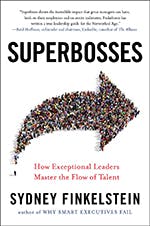Whether they are producing breakfast cereal or supercomputers, manufacturers need the same precious commodity these days – talent. Given the turmoil in manufacturing as new technologies and global competitors keep pushing the pace and changing the skill sets needed in companies, talent has become less a buzzword and more like a constant roar of necessity.
Human resource departments can call on a horde of tests and procedures to identify the right candidates for a job. But in this era of increasing scientific rigor, leadership guru Sydney Finkelstein says there is still an important role for talent spotting, and some of the best leaders in the world practice it.
In his new book Superbosses: How Exceptional Leaders Nurture Talent to Achieve Market Domination (Portfolio|Penguin, 2016), Finkelstein, a professor at the Tuck School of Business at Dartmouth, profiles the practices of leaders who are particularly adept at attracting talent, inspiring them to achieve beyond what they might ever have expected and then keeping them as part of a widening circle of influence. These superbosses range from football coaching legend Bill Walsh to chef Alice Waters and semiconductor pioneer Robert Noyce.
How do superbosses look for and hire talent? Finkelstein told IndustryWeek that most companies create a job description and look for candidates whose attributes tick off the most boxes. In some cases, superbosses may throw the job description out the door.
“They will look for the right person and create a job for that person,” said Finkelstein. “They are always on the lookout for that person who may have that something special.”
Superbosses also look for talent in places where others are not looking, Finkelstein says. Fashion mogul Ralph Lauren, for instance, would offer jobs to strangers he met by chance while dining at New York City restaurants.
“It’s such a genius thing to do when you really think about it,” Finkelstein observes. “If everyone is looking in the same talent pool, then it is going to be tougher to find those special people.”
Director George Lucas, Finkelstein notes, hired Ph.Ds to help him create the technology for the Star Wars film. Bill Walsh developed a minority internship program to hire African-American coaches, a largely untapped resource. Jay Chiatt, whose advertising firm created the Apple “1984” commercial, hired women for creative jobs when many in the industry still saw women as secretaries.
Finkelstein says superbosses are extraordinary motivators who have the ability to spell out a compelling vision for the company and look for people who can share in the pursuit of that vision. In the end, writes Finkelstein, they choose key associates based on “how well they ‘get’ what the superboss is trying to do.” Gene Roberts, former editor of the Philadelphia Inquirer, chose his managing editor on his judgment that the editor “had what the job needed.”
Choosing top talent that can push a company forward isn’t confined solely to the realm of superbosses such as Larry Ellison or Miles Davis. Finkelstein cites three main attributes any hiring manager can look for:
Unusual Intelligence. Finkelstein says superbosses want “everyone around them to be as smart as possible.” Ralph Lauren, he notes, “wanted everyone who worked for him, even in the most menial roles, to have a fashion sense and be able to say interesting things about clothes.” Superbosses use a variety of non-conventional interview techniques to find these people.
Creativity. Superbosses, Finkelstein writes, want employees who can “tackle problems originally and differently.” Even more, they want them to be able to apply these ideas and accomplish something. That’s one reason a variety of these leaders were known to listen intently to job applicants to “hear how they think.”
Extreme Flexibility. Superbosses want employees who can apply their talents to a variety of challenges, not simply serve as specialists. Roger Corman, for example, hired a young Jack Nicholson as both a writer and director. Gene Roberts, notes Finkelstein, would “take someone who had been processing comic strips and make him a feature writer, or … assign a sportswriter to cover politics.”
Finkelstein says the superboss approach to spotting talent may seem "risky and dangerous" to hiring managers. But he points out that the "track record that superbosses bring to the challenge is so overwhelmingly positive that we'd be crazy not to try."





